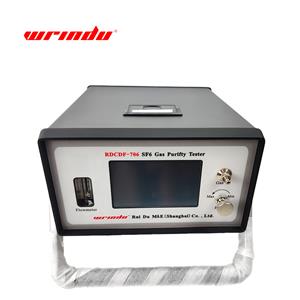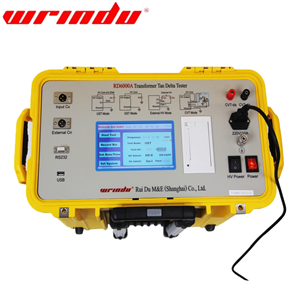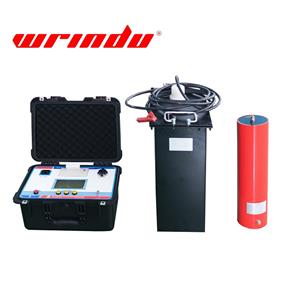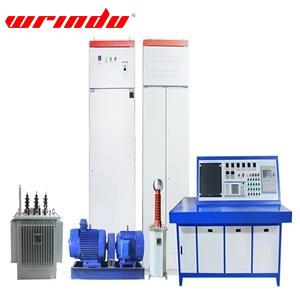Common problems and solutions of series resonance withstand voltage test of transformer
Q: what are the AC withstand voltage test methods using the series parallel resonance principle?
A: For AC withstand voltage test of test objects with large capacitance such as long cable lines, capacitors, large generators and transformers, test equipment and power supply with large capacity are required, which is often difficult to do on site. In this case, series, parallel resonance or series parallel resonance (also known as series parallel compensation) can be used to solve the problem of insufficient capacity of test equipment according to specific conditions.
(1) Series resonance (voltage resonance) method. When the rated voltage of the test transformer cannot meet the required test voltage, but the current can meet the test current of the tested object, the shortage of test voltage can be solved by series resonance.
(2) Parallel resonance (current resonance) method. When the rated voltage of the test transformer can meet the requirements of the test voltage, but the current cannot reach the test current required by the tested object, parallel resonance can be used to compensate the current to solve the problem of insufficient test power capacity.
(3) Series parallel resonance method. In addition to the above series and parallel resonance, when the rated voltage and rated current of the test transformer cannot meet the test requirements, the series and parallel resonance lines can be used at the same time, also known as series parallel compensation method.
Q: what are the conditions for voltage resonance? What are the conditions for current resonance?
A: in the circuit composed of inductance coil (which can be simulated by inductance L series resistance R) and capacitive element (capacitance C) in series, voltage resonance will occur when the inductive reactance is equal to the capacitive reactance. The in-depth analysis is as follows:
(1) When l and C are constant, the frequency f of the power supply is exactly equal to the natural oscillation frequency of the circuit, that is, f = 1 / (2 π√ LC).
(2) When the power frequency is constant, adjust the inductance L so that l = 1 / [(2 π f) 2C].
(3) When the power frequency is constant, adjust the electric capacity C so that C = 1 / [(2 π f) 2L]. In the circuit composed of inductance coil (which can be simulated by inductance L series resistance R) and capacitive element (capacitance C) in parallel, current resonance will occur if one of the following conditions is met.
(1) Power frequency f = 1 / 2 π√ 1 / lc-r / L
(2) Adjust the electric capacity so that C = L / [R2 + (2 π FL) 2]
(3) When 2 π FCR ≤ 1, adjusting inductance L may also produce current resonance.
Q: what are the methods of series resonance withstand voltage test of transformer?
Answer: there are two common series resonance withstand voltage test methods for transformers:
(1) Inductive series resonance withstand voltage test. An adjustable inductance L is connected in series in the high-voltage circuit. When the reactor is adjusted so that WL1 / WCX =, the voltage drop on the reactance is numerically equal to the voltage drop on the capacitor, the circuit reaches the resonant state, and the power frequency high voltage is generated on the tested object.
(2) Frequency conversion series resonance withstand voltage test. When the frequency converter is connected to the test power supply, the power frequency can be adjusted to change within 30-300hz. When the output voltage frequency of the frequency converter cabinet reaches the resonance condition, i.e. f = 1 / (2 π√ LC), a resonant high voltage will be generated on the test object. If the reactor combination and capacitance are adjusted at the same time, the test frequency can be controlled within the frequency range of 45 ~ 65fhz, and most can be controlled within the frequency range of 49 ~ 51hz. Because it is convenient for the regulating equipment to reach the non vibration point, it is commonly used on site at present.
Q: what are the precautions when conducting the series resonance withstand voltage test of the transformer?
Answer: when conducting series resonance voltage withstand test of transformer, attention shall be paid to:
(1) It should be tuned before boosting. When series resonance test device is adopted, the frequency of test voltage shall not be lower than 40Hz, and the withstand time under full voltage shall be 60s. During the test, the inductance or frequency shall be tuned under the low excitation voltage to find the resonance point. When the voltage on the test object reaches the highest, that is, the resonance point of the test circuit can be reached, and the boost test can be started.
(2) The quality factor Q value of resonance test circuit is related to the dry and clean degree of test equipment and test object insulation surface, as well as the diameter and length of high-voltage lead, so the test should be carried out in sunny weather. The insulation surface of test equipment and test object shall be dry and clean. Shorten the length of high-voltage lead as far as possible and use large-diameter high-voltage lead to reduce corona loss. Improve the quality factor Q value of the test circuit.
Q: what are the possible reasons for unqualified insulation of power equipment during voltage withstand test?
Answer: during voltage withstand test, the possible reasons for unqualified insulation of power equipment are:
(1) Insulation deterioration. For example, moisture in transformer oil, moisture in solid insulation, insulation aging, etc. will lead to the decline of insulation performance, which may be unqualified during voltage withstand test.
(2) The test method and voltage measurement method are incorrect. For example, during the transformer test, if the non tested winding is not short circuited to the ground, the non tested winding may discharge to the ground and be misjudged as unqualified. For another example, when testing the high-capacity test object, the voltage is still measured at the low-voltage side. Due to the capacity rise effect, the voltage actually applied to the test object exceeds the test voltage, resulting in the breakdown of the test object and misjudged as unqualified.
(3) Atmospheric conditions affecting insulation characteristics are not properly considered. Because air pressure, temperature and humidity have certain effects on spark discharge voltage and breakdown voltage, if these factors are not considered, it may lead to the conclusion that the equipment is unqualified.




